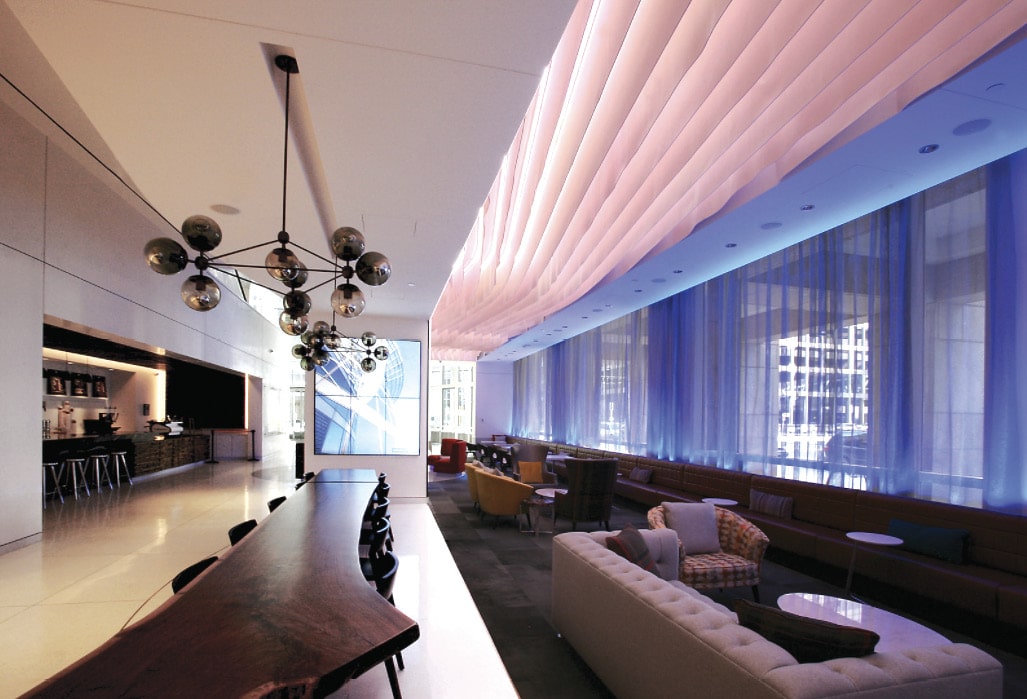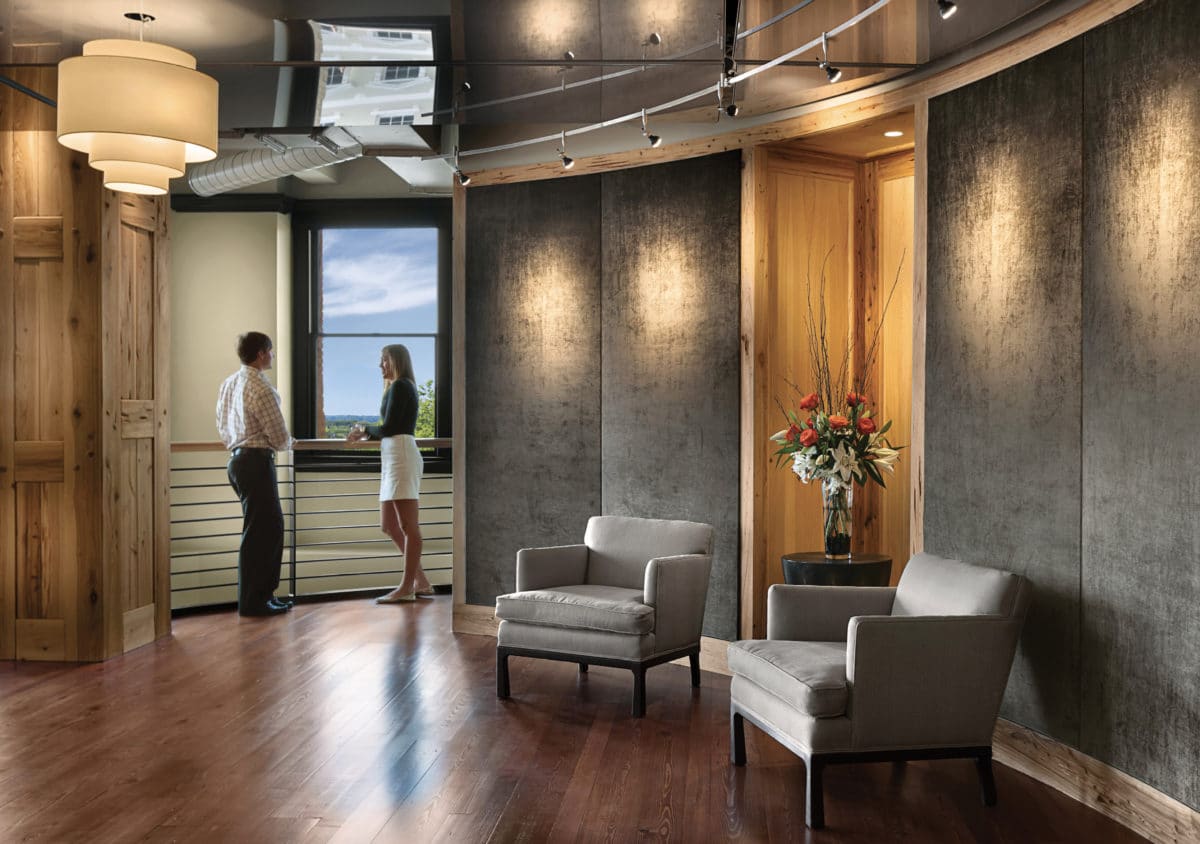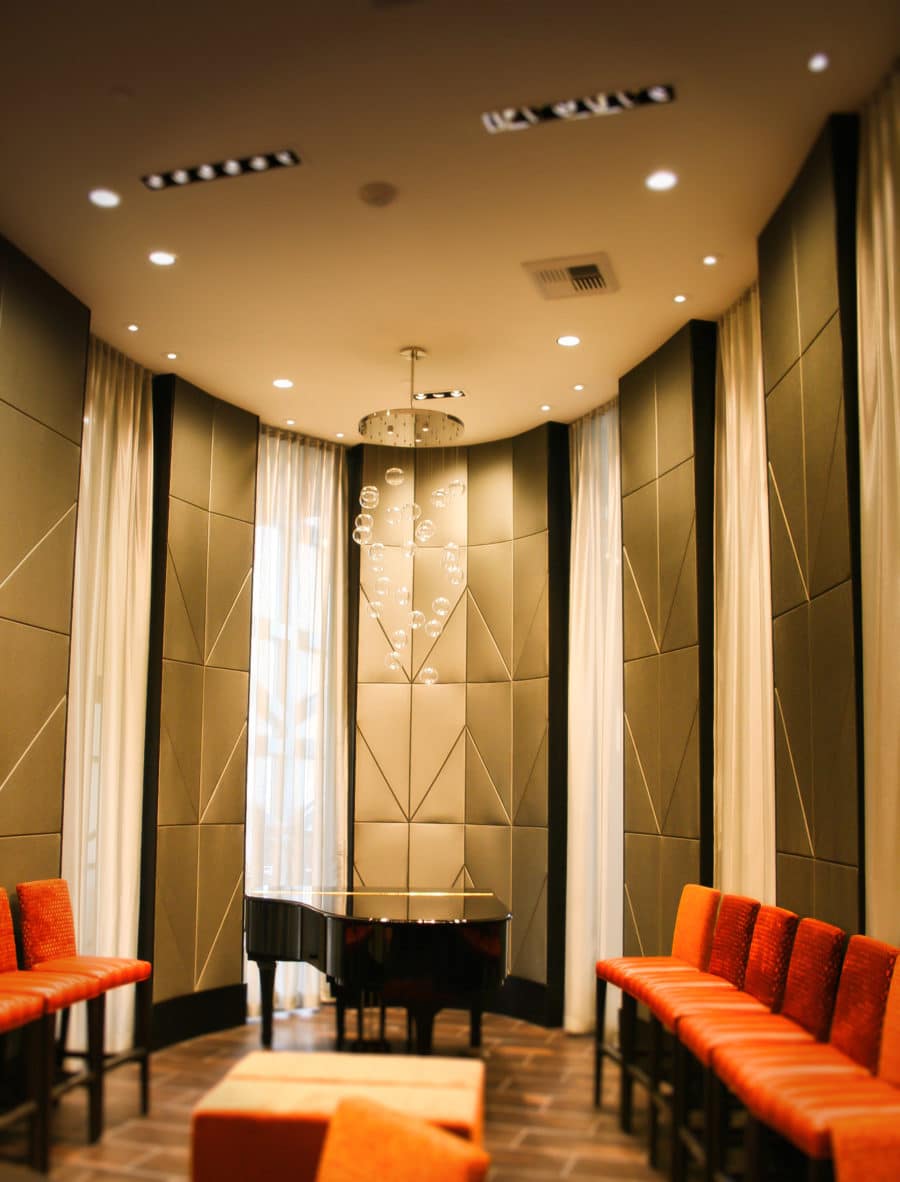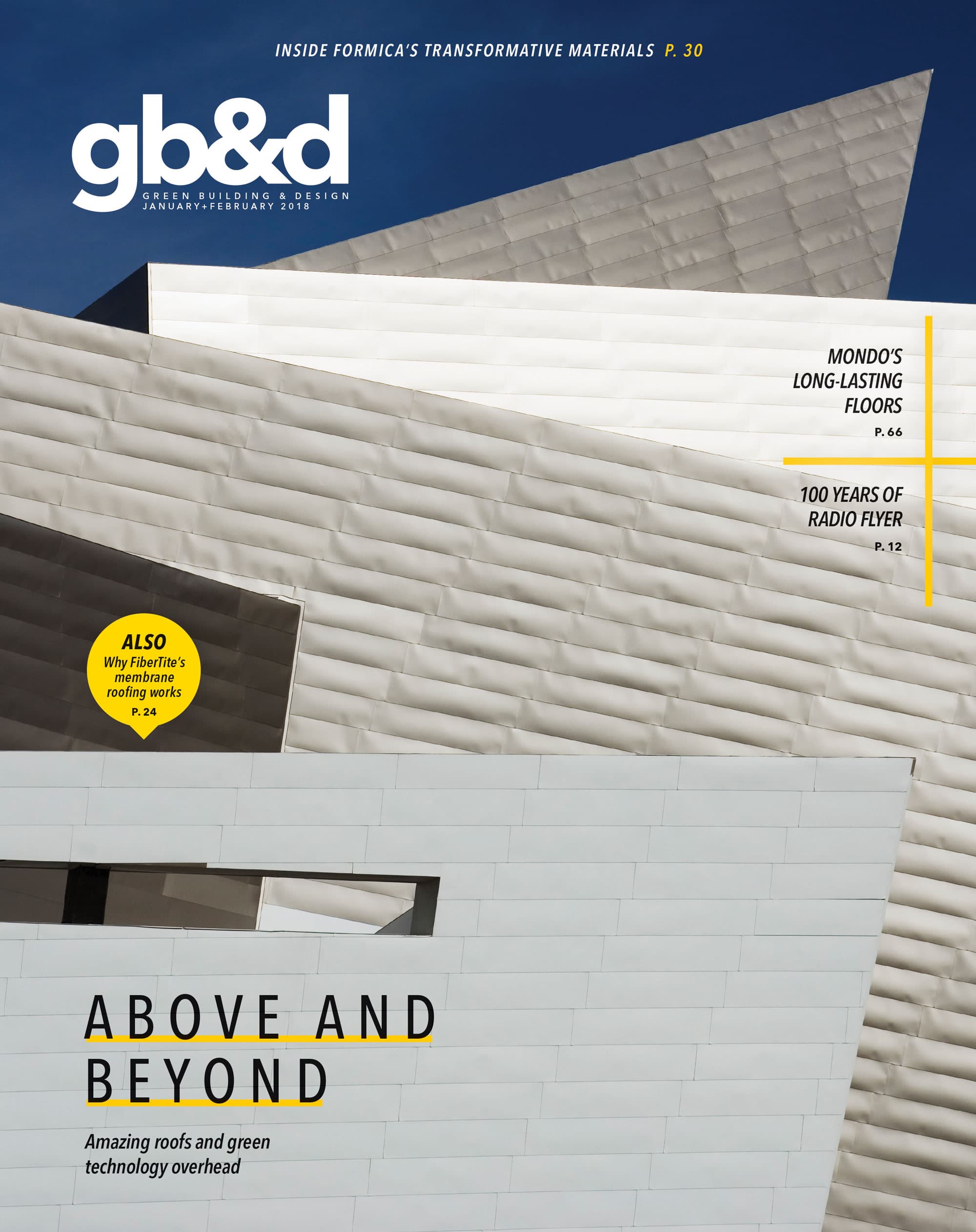
FabriTRAK’s acoustical products transform beautiful spaces to make them even better. [Photo: Courtesy of FabriTRAK]
Why architects and designers should care about how a space “sounds.”
Acoustics is one of those design considerations that tends to land on the project priority spectrum somewhere around “afterthought” and “budget-dependent.” “Typically, acoustics is either never considered or quickly cut from a project, but it tends to be the first thing end-users complain about once the project is complete,” says Bart Moore, president and CEO of acoustical products company Bartley Group.
In other words, high acoustic quality—and the products that help achieve it—don’t usually get project points for being aesthetically sexy. And yet they’re absolutely essential to how a space functions. We’ve all had the experience of being in a jarring public environment to prove the point: a restaurant where the din drowns out the person next to us, a museum hall that amplifies footsteps, an open office where every whisper travels.
This “noise pollution” comes from reflected sounds, explains Steven Frost, vice president of FabriTRAK, a company that specializes in acoustic finishes. “Initially, you only hear the source of the sound (the person or speaker) and then it gets reflected off of the room’s surfaces many, many times—and that’s what makes a space uncomfortable.”
FabriTRAK’s line of sound-dampening fabric treatments for walls and ceilings work to absorb anywhere from 75 to 95% of these reflected sounds, not only optimizing the acoustics of a variety of spaces but offering creative possibilities to the architects and designers behind them. And better yet, the company innovates with eco-friendly materials along the way.
FROM OUR JANUARY+FEBRUARY 2018 ISSUE
The preferred publication of leading green professionals.

[Photo: Courtesy of FabriTRAK]
Design Flexibility
From its early days, FabriTRAK has been concerned with beautiful design. In the late ’70s the company was started (under a different name) by Floyd Baslow, an entrepreneur who wanted to bring the elegant interior tapestries of France to the U.S. design market.
Baslow’s interpretation of the French concept centered on two main components—fabric and track, hence the company’s current name—which came together to form neatly taut wall coverings. These panels not only brought beauty to interiors but helped reduce noise. While Baslow was at first unlucky in marketing the concept straight to homeowners, he began working with dealers of interior finishes and the product took off.
That design has evolved into what remains the company’s core product today. Here’s how it works: A network of flexible tracks that holds the fabric using “jaws” (rather than adhesives or staples) is applied to the wall or ceiling. Those tracks then receive a layer of sound-absorbing infill, which is covered by any number of fabrics that are fire-tested, moisture-resistant, and acoustically transparent—meaning, sound can travel through them. Because the track itself is made of pliable PVC, these systems can be applied to columns, doors, hanging ceilings, and curved walls—virtually any unconventional or contoured surface an architect can dream up. “The track is a framework that you can reasonably make any shape or size you want,” says President and CEO Lou D’Angelo. “It allows a designer’s creativity to come forth.”
For the Waldorf Astoria hotel in Orlando, Florida, for example, FabriTRAK cloaks the dome of the lobby, creating a focal point for the space and making conversations below intelligible. The company’s line appears in any space where sound travel or group communication is a factor—movie theaters, ballrooms, churches, auditoriums, conference rooms, offices, hospitals (featuring antimicrobial fabric), even a large yacht, and others.

[Photo: Courtesy of FabriTRAK]
Eco-Friendly Impact
For yet another client, Google, FabriTRAK faced an interesting challenge: to create a system of track that was free of PVC (or polyvinyl chloride)—a plastic the tech giant wanted to minimize in its facilities. “This was not easy to do,” D’Angelo says. “Most PVC-free materials don’t lend themselves to being formed into the geometry of a track while still being pliant.”
The company innovated to come up with a proprietary material worthy of the Declare Label—an eco-friendly stamp of approval declaring a product’s lack of Red List ingredients. To pair with this new PVC-free track (called GeoTRAK) and to create a complete system of green products, the company also engineered eco-friendly infills and fabrics. Both used as acoustical infill, EcoTACK is made of formaldehyde-free fiberglass and TerraCore Poly is made of recycled polyester. And, EcoSPAN is a 100% recycled fabric that can be color-matched to virtually any Pantone or paint
chip. “The entire system is Red List-free and VOC-free,” Frost says.
Innovations in Sound
In addition to these eco-friendly innovations, the company has also lately experimented with ways to make its products more design-forward. They’ve recently developed a range of wide-width fabrics that span up to 16 feet—perfect for large-scale projects—as well as a line of acoustic art panels that can be printed to feature custom digital images. (The company’s conference room features an image of the Grand Canal in Venice.) And they’ve expanded their color range, too, offering the ability to create literally millions of color combinations for the fabrics used in their systems.
This approach means that, for the architects and designers who use FabriTRAK in their projects, achieving strong acoustics doesn’t have to come at the expense of good design. In fact, it can even be a gateway to new, creative possibilities. And visitors to these spaces likely won’t even detect the acoustical nature of the products. They might notice the beautiful wall or ceiling treatment—and then comfortably carry on with their conversation.

[Photo: Courtesy of FabriTRAK]
BEFORE & AFTER
A space with poor acoustic design is an unpleasant, dysfunctional space, according to FabriTRAK acoustician Tony Sola of Acoustical Consulting Services. “Without proper acoustic control, a space can become noisy, speech can be unintelligible, reflections can be annoying, and the space simply might not function,” Sola says.
FabriTRAK products work to bring the noise level down to the ideal range of 80 to 95% sound absorption (that’s absorption of reflected or unwanted sounds, not original sounds). “No one likes to speak above a certain octave level,” says D’Angelo. “You need to modulate sound by having a material finish that absorbs reflective sounds and makes a room pleasant to speech.” We like the sound of that.
WHY THIS MATTERS
- FabriTRAK’s line of wall and ceiling treatments absorb anywhere from 75 to 95% of reflected sounds—the noises that bounce around a space and make conversation uncomfortable.
- The track used in the company’s systems is highly pliable, so it can be installed on a variety of unconventional surfaces, from columns to curved walls.
- With features like wide-width fabrics, custom art printing, and expansive color-matching, good sound quality doesn’t have to mean drab design.
- Through FabriTRAK’s eco-friendly line, projects can have optimal acoustics while also leaving out PVC, VOCs, and other potentially harmful Red List materials.
- The company works with acoustical consultants who advise on how to best use FabriTRAK in various projects, as well as trained installers who are experts in configuring the system and working with different fabrics.
- FabriTRAK products have been fire tested to ASTM E84and ASTM E2573 and passed as Class “A.”
Learn more about FabriTRAK.

